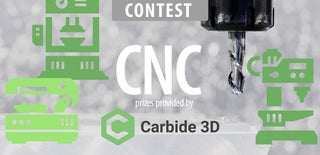Introduction: Kids Toy Scale on a Desktop-CNC
Girls like to play 'toy grocer's shop'. You can buy toy scales, but they really are that imprecise it spoils the fun. Building a kids toy scale isn't an impossible task. I used tiny ball-bearings and the idea of a parallelogram for the arms to get a smooth action and the weighing pan stay level.
This instructable doesn't target on creating a toy scale as such, it is more like showing a way to go from a rough idea to a finished products. If you want to build this scale, you can grab the CAD-file, go to your cnc and cut out the parts.
You will need at least one sheet of 6 mm plywood (30 cm x 40 cm) and a small roundwood (5 mm Ø). I did use beech wood as it gives a nice surface when sanded and it's solid, relatively inexpensive and widely available. Further more you'll need 6 small ball bearings (ZZ685 5x11x5 mm) and two washers (M5).
Step 1: Research an Idea
After some research on the web I started out with rough sketches of the basic principle. As the first decisions about final size where made, I had the maximum machining size in mind. Sketching with pencil and paper does work best for me.
Step 2: Determine in CAD
Then went over to a 2D-CAD-Software (Solid Edge 2D Drafting) and determined the idea. In this phase I used a flattened 2D-explosion style which helps to get the construction correct.
Step 3: Check the Model
In order to save material I did build a 3D model of my 2D CAD drawing using SketchUp. It's really a matter of extruding a parts to material width and placing them right. This really helps to verify the construction. In most cases this step has to be done several times, till all parts fit.
Step 4: Get a 'real' Impression
When I have a correct 3D model I do a 3D rendering. I did this rendering with
Fusion360. It's simple to import a model, apply some textures and get a beautiful rendering.
Step 5: Nesting and Cutting the Parts
When the construction was done and verified, I nested the parts as close as possible. On a cnc-machine you have to keep the tool-diameter in mind. As I was building the scale with 6 mm beech plywood I could use a very fine cutter (1.2 mm). I was really surprised to find that nearly all parts fitted on a sheet (30 cm x 40 cm) plywood.
The task of cutting parts on a cnc includes creating the tool path (CAM) and the actual cutting with the control (CNC). I will not go into detail in this instructable as there is plenty of material out on the web (or like here at Instructables as such).
Step 6: Cut and Glue
After cutting the parts, I sanded and glued them together. I pressfitted the ball-bearing into the pivot points and used small peg as shafts. They were put in place by a soft-head hammer. I did add washers in the center points to ensure free spinning. The final assembly is quick and super simple.
Step 7: Final Assembly
You can download the drawing right here or at ZenziWerken
There you''ll find some more projects you can make with a small sized desktop cnc. I did use a Stepcraft 420 to build my toy scale.

Participated in the
CNC Contest 2016















